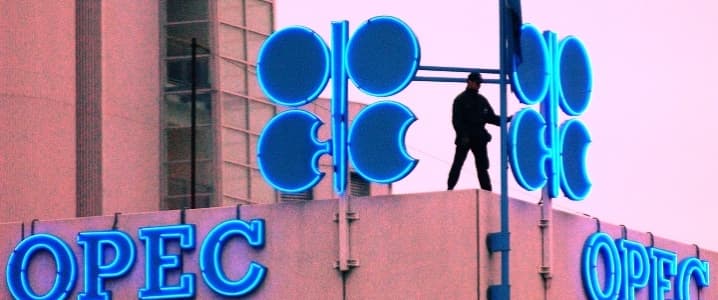The OPEC extension keeps the oil market on track to balancing at some point next year, but if the group overshoots on tightening, OPEC members could begin cheating, potentially leading to an unraveling of the deal.
To be sure, there is a great deal of uncertainty over the pace of inventory drawdowns. The IEA predicts a return to rising inventories in the first half of 2018, a prospect that threatens another downturn in prices. In this scenario, OPEC will struggle to balance the market, and may be forced into yet another extension. Indeed, there are some analysts who see the downside risk as a much greater threat than the upside, and that the oil market should brace for lower prices.
But let’s look at the bullish case for a moment.
The inventory surplus has dramatically narrowed this year, falling to just a little more than 100 million barrels above the five-year average as of October, down more than two-thirds from the start of 2017. That obscures the fact that the drawdowns really kicked into high gear only in the second half of this year, a rapid drawdown that coincided with a sharp uptick in prices.
Meanwhile, OPEC compliance hit its highest point in November, which should continue to put pressure on stocks in the next few months. And while the IEA sees stock increases pouring cold water on the oil market, other analysts downplay such a scenario. Goldman Sachs argues that the inventory increases in the first quarter of 2018 will be much smaller than the typical gains for that time of year, with stocks once again drawing down by the second quarter.
Related: The Drastic Drop Off In U.S. Oil Imports
Unexpected outages could tighten the market more than anticipated, with Venezuela as one particular hotspot of uncertainty.
The oil market will “rebalance” by mid-2018, Goldman Sachs said in its report, before adding this intriguing prediction: “leading to a gradual exit from the cuts and increases in OPEC and Russia production through 2H18.”
In other words, OPEC will have completed its mission—or at least will be close—at about the time it meets again in Vienna in June. Thereafter, with oil prices rising and the inventory surplus eliminated, the justification for OPEC’s production cuts will lose their urgency, and members will be tempted to cheat.
Indeed, even before we get there, higher oil prices “would be an open invitation to cheat,” according to Ole Hansen, head of commodity strategy at Saxo Bank. “That could lead to a collapse of the deal.”
Russia is one of the bigger question marks. Russian officials voiced some skepticism in the lead-up to the most recent extension and have also expressed an eagerness to exit the deal as soon as the market surplus is eliminated.
There are a few reasons why the impetus to cheat will grow along with oil prices. First, higher prices will prove to be tempting, because each additional barrel will bring in even more revenue. Second, at some point in 2018, as inventories fall and prices rise, OPEC members will know that the expiration of the deal will not be far off, so why not get a head start on a return to higher production levels?
Third, OPEC members know that higher oil prices are a real danger to their market share because it could provoke an aggressive response from U.S. shale drillers. “Do we want [prices] to continue upwards indefinitely? Not really,” Nigerian Oil Minister Emmanuel Ibe Kachikwu told The Wall Street Journal, referring to fears of sparking too much investment and drilling in U.S. shale.
Related: U.S. Asks China To Implement New Oil Sanctions On North Korea
Other OPEC officials expressed concern when Brent rose to $65 per barrel earlier this month, according to the WSJ. One official told the WSJ that “you are attracting problems for yourself” with oil up in the mid-$60s. At that level, OPEC fears, U.S. shale will add a wave of new supply. “If prices are attractive for other producers, we will be going back to square one,” the official said.
The problem for OPEC is that it’s a tricky balancing act, and it isn’t clear that there is a price window that will satisfy the needs of OPEC members while also proving to be low enough to stave off new shale investment.
In fact, the IEA and OPEC itself see massive supply increases from U.S. shale as it is. The IEA predicts the U.S. will add 870,000 bpd of new supply in 2018, while OPEC estimates U.S. shale growth of more than 1 mb/d. The best outcome for OPEC, it seems, would be a continuation of stable prices that allow for a drawdown in stocks and some rise in U.S. shale supply, but not too much.
Still, even in that scenario it’s a sacrifice for OPEC because the end result will be a smaller market share for the cartel.
By Nick Cunningham of Oilprice.com
More Top Reads From Oilprice.com:
- The Stunning Energy Cost Of Tesla’s Semi-Truck
- Should The State Take Over Pacific Gas & Electric?
- Gasoline Prices Begin To Fall As Demand Tapers Off



















Yet, who cares. Oil at or near $60 is great for U.S. shale oil production. Technology has rapidly lowered the cost, and the speed in which oil can be brought to market. U.S. production has already started to rise, and it will outstrip all the estimates as long as oil stays above $50. OPEC and Russia will have to continue to idle more capacity if they want to keep the price of oil from cratering. All of that is great news for the USA. Sooner or later though the Psychology of thinking of oil as a scarce resource as production continues to grown, and more and more capacity is idled just sitting there will break, and when that does the price will drop. We are in a transition phase over the next 30 to 50 years in which oil will phase out, not run out.